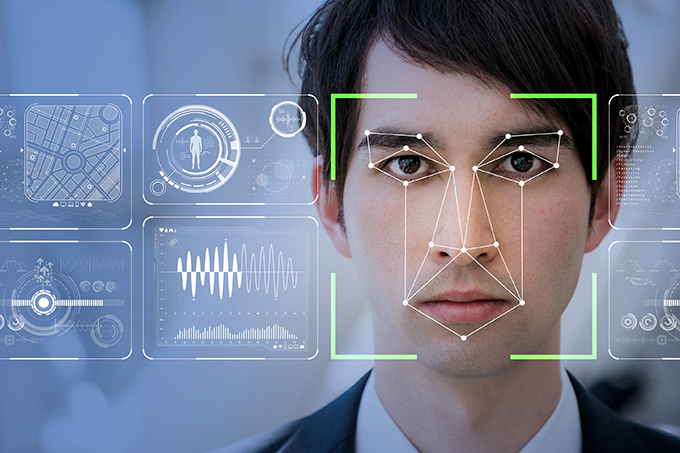Face recognition is a biometric software application that is able to identify or verify someone by comparing and analyzing patterns based on the contours of the person’s face. Face recognition is mostly used for security purposes, although there is increasing interest in other fields of use. The face recognition system uses biometrics to map facial features from photos or videos. It compares the information with known face databases to find matches. Face recognition can help verify personal identity but also creates privacy problems.
The face recognition market is expected to grow to $ 7.7 billion by 2022 from $ 4 billion in 2017. That’s because face recognition has all kinds of commercial applications. This can be used for everything, from supervision to marketing.
But that’s where it’s complicated. If privacy is important to you, you might want to control how your personal information – your data – is used. And here’s the problem: Your “front print” is data.
How facial recognition works?
You may be good at recognizing faces. You might easily identify the faces of family members, friends, or acquaintances. You are familiar with their facial features – eyes, nose, mouth – and how they meet.`
That’s how facial recognition systems work, but on a large scale, algorithmic. Where you see faces, the introduction of data technology. The data can be stored and accessed. For example, half of all American adults have their images stored in one or more face identification databases that law enforcement agencies can search for, according to a Georgetown University study.
So how does facial recognition work? Technology varies, but these are the basic steps:
Step 1. Your face is taken from a photo or video. Your image may show you are looking straight ahead or almost on the profile.
Step 2. Face recognition software reads the geometry of your face. Key factors include the distance between your eyes and the distance from your forehead to your chin. The software identifies face landmarks – one system identifies 68 of them – which is the key to distinguishing your face. The result: sign your face.
Step 3. Sign your face – mathematical formulas – compared to known face databases. And consider this: at least 117 million Americans have their face images in one or more police databases. According to a May 2018 report, the FBI has access to 412 million face images for search.
Step 4. Printing your face might match the image in the face recognition system database.
Who uses facial recognition?
Many people and organizations use face recognition – and in many different places.
1. U.S. Government at the airport. The face recognition system can monitor people who come and go at the airport. The Department of Homeland Security has used technology to identify people who have extended their visa validity period or maybe in criminal investigations. Customs officers at Washington Dulles International Airport made their first arrests using facial recognition in August 2018, arresting a fraudster who tried to enter the country.
2. Cellphone makers in products. Apple first used face recognition to unlock the iPhone X, and continue with the iPhone XS. Face ID Authentication – ensures you when you access your mobile. Apple says the possibility of random faces unlocking your cellphone is around one in 1 million.
3. Colleges. Face recognition software can, in essence, rollover. If you decide to leave the class, your professor can know. Never think of sending your smart roommate to take your test.
4. Social media company on the website. Facebook uses algorithms to see faces when you upload photos to the platform. Social media companies ask if you want to tag people in your photos. If you answer yes, it creates a link to their profile. Facebook can recognize faces with 98 percent accuracy.
5. Business at the entrance and limited area. Some companies have traded security badges for facial recognition systems. Beyond security, it can be one way to get face-to-face time with the boss.
6. Religious groups in places of worship. The church has used face recognition to scan their congregation to see who is present. This is a good way to track regular and non-permanent customers and help adjust donation requests.
7. Retailers at the shop. Retailers can combine surveillance and face recognition cameras to scan the faces of buyers. One goal: identify suspicious characters and potential shoplifters.
8. Departure gate of airlines. You might be accustomed to asking an agent to scan your boarding pass at the gate to get on your plane. At least one airline scans your face.
9. Marketers and advertisers in campaigns. Marketers often consider things such as gender, age, and ethnicity when targeting groups for a product or idea. Face recognition can be used to define the audience even at something like a concert.
Reasons to worry about your privacy
1. Privacy issues. Privacy refers to whatever rights you have to control your personal information and how that information is used – and that can include your faceprint.
So, what’s the problem? Here are a few:
2. Security. Your face data can be collected and stored, often without your permission. Hackers who might be able to access and steal that data.
3. Prevalence. Face recognition technology is broader. That means your signature can end up in many places. You probably won’t know who has access to it.
4. Ownership. You have your face – which is above your neck – but your digital image is different. You may have handed over your ownership rights when registering on social media networks. Or maybe someone tracks your picture online and sells that data.
5. Security. Face recognition can cause abuse and online stalking. How? For example, someone takes your photo on the subway or other public place and uses facial recognition software to find out who you really are.
6. Wrong identity. Say, for example, law enforcement uses face recognition to try to identify someone who robbed a corner shop. The face recognition system may not be 100 percent accurate.
7. Basic freedom. Government agencies and others can have the ability to track you. What you do and where you go may no longer be personal. It becomes impossible to remain anonymous.
Advantages of facial recognition technology
1. Security
The automatic security process also means that fewer security personnel will be placed in potentially dangerous situations.
2. Fast and Accurate
With the increasing demand for speed and the increasing number of cyber attacks, having fast and accurate technology is the key. Face recognition technology provides verification that is convenient, fast, and accurate. While it is possible, it is very difficult to fool face recognition technology, which makes it useful in helping prevent fraud.
3. Security
A face biometric security system can dramatically improve your security because every individual who enters your place will be taken into account. Each intruder will be quickly captured by the recognition system and you will be warned immediately. With a face recognition security system, you have the potential to reduce the cost of hiring security staff.
4. Fully Automatic
Instead of a manual introduction, which is carried out by security guards or official representatives outside the company’s location, facial recognition technology automates the process of identifying and ensuring its imperfections at any time without stopping. You don’t even need employees to monitor cameras 24/7. Automation means convenience and reduced costs too. Therefore, every entrepreneur will love the fact that the image identification system is fully automated.
5. Cost savings
Because of automatic face recognition, this also reduces the need for security guards to personally verify compatibility. This means businesses can save costs in recruiting security staff and other security measures.
6. Easy integration process
Most of the time, integrated face recognition tools can work perfectly with company-installed security software. And they are also easy to program to interact with company computer systems.
Conclusion:
Face recognition is a new technology that can provide many benefits. Face recognition can save resources and time, and even generate new revenue streams, for companies that implement it correctly.
According to Global Market Analysis, face recognition system revenues are estimated to reach revenues of $ 888.2 billion in 2024, expecting growth of 36.07% CAGR (Compound Annual Growth Rate). What drives this level is its popularity among the consumer market and sectors such as Banking, Health, Law, and Education. With this high level, face recognition does not leave behind the missed business needs with innovative and innovative inventions made every day in this field. Providing tantalizing opportunities, the future of facial recognition systems is clearly bright in terms of funding and public interest.
Author Bio:
Naaz Aniqua is an influential digital marketer works at apps development company in Indianapolis and helps to rank a website on search engine and build cultivating potential customers and make an audience base. She is very good content and article writer and contributing her article and blogs regularly which includes balanced informative with IT needs.





